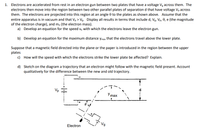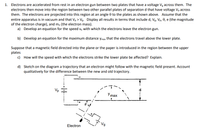
Introductory Circuit Analysis (13th Edition)
13th Edition
ISBN: 9780133923605
Author: Robert L. Boylestad
Publisher: PEARSON
expand_more
expand_more
format_list_bulleted
Question

Transcribed Image Text:1. Electrons are accelerated from rest in an electron gun between two plates that have a voltage Vg across them. The
electrons then move into the region between two other parallel plates of separation d that have voltage V, across
them. The electrons are projected into this region at an angle 0 to the plates as shown above. Assume that the
entire apparatus is in vacuum and that Vp > Vg. Display all results in terms that include d, Vg, Vp, 0, e (the magnitude
of the electron charge), and mo (the electron mass).
a) Develop an equation for the speed ve with which the electrons leave the electron gun.
b) Develop an equation for the maximum distance ymax that the electrons travel above the lower plate.
Suppose that a magnetic field directed into the plane or the paper is introduced in the region between the upper
plates
c) How will the speed with which the electrons strike the lower plate be affected? Explain.
d) Sketch on the diagram a trajectory that an electron might follow with the magnetic field present. Account
qualitatively for the difference between the new and old trajectory.
Vp
Y max
Ng
Electron
Expert Solution
This question has been solved!
Explore an expertly crafted, step-by-step solution for a thorough understanding of key concepts.
This is a popular solution
Trending nowThis is a popular solution!
Step by stepSolved in 6 steps with 1 images

Follow-up Questions
Read through expert solutions to related follow-up questions below.
Follow-up Question
Please answer part d and please explain where the magnetic field will be and how will the magnetic field behave?

Transcribed Image Text:1. Electrons are accelerated from rest in an electron gun between two plates that have a voltage Vg across them. The
electrons then move into the region between two other parallel plates of separation d that have voltage V, across
them. The electrons are projected into this region at an angle 0 to the plates as shown above. Assume that the
entire apparatus is in vacuum and that Vp > Vg. Display all results in terms that include d, Vg, Vp, 0, e (the magnitude
of the electron charge), and mo (the electron mass).
a) Develop an equation for the speed ve with which the electrons leave the electron gun.
b) Develop an equation for the maximum distance ymax that the electrons travel above the lower plate.
Suppose that a magnetic field directed into the plane or the paper is introduced in the region between the upper
plates
c) How will the speed with which the electrons strike the lower plate be affected? Explain.
d) Sketch on the diagram a trajectory that an electron might follow with the magnetic field present. Account
qualitatively for the difference between the new and old trajectory.
Vp
Y max
Ng
Electron
Solution
by Bartleby Expert
Follow-up Questions
Read through expert solutions to related follow-up questions below.
Follow-up Question
Please answer part d and please explain where the magnetic field will be and how will the magnetic field behave?

Transcribed Image Text:1. Electrons are accelerated from rest in an electron gun between two plates that have a voltage Vg across them. The
electrons then move into the region between two other parallel plates of separation d that have voltage V, across
them. The electrons are projected into this region at an angle 0 to the plates as shown above. Assume that the
entire apparatus is in vacuum and that Vp > Vg. Display all results in terms that include d, Vg, Vp, 0, e (the magnitude
of the electron charge), and mo (the electron mass).
a) Develop an equation for the speed ve with which the electrons leave the electron gun.
b) Develop an equation for the maximum distance ymax that the electrons travel above the lower plate.
Suppose that a magnetic field directed into the plane or the paper is introduced in the region between the upper
plates
c) How will the speed with which the electrons strike the lower plate be affected? Explain.
d) Sketch on the diagram a trajectory that an electron might follow with the magnetic field present. Account
qualitatively for the difference between the new and old trajectory.
Vp
Y max
Ng
Electron
Solution
by Bartleby Expert
Knowledge Booster
Learn more about
Need a deep-dive on the concept behind this application? Look no further. Learn more about this topic, electrical-engineering and related others by exploring similar questions and additional content below.Similar questions
- I. SOLVE THE FOLLONING PROBLENS : A COPPER WIRE OF 0,3 Mm RAAUS HAS A LEN ETH OF 1. JOM- IF THE RESISTIVITY of cOpPER IS 1-7 x0 WHAT WOULD BE THE RESISTANOE OF THE WIRE? OF A 100m WIRE IS 1035 mm AND 3.7 OHMS. WHAT 2. THE DIAMETER THE REISTANCE IS IS THE CONDUCTIVITY 3. WHAT WILL BE THE VALUE OF A CAPACITOR WHEN IT HAS A CAPACITIVE REACTANCE OF 300R ANP to A 6o HZ. SUPPLY? IN FARADS IS CONNECTED 4. WHAT Is THE VALUE OF THE RESISTOR WITH THE FOLLOWING COLORS ? A. BROWN, BLACK, GOLD, REP B. BLUE YELON BROWN, SILVER PED, SILVER, BROWN, VIOET C. 5. AND t WHEN V 220V AND R= 50n WHEN I = 45 A WHEN V = 120V FIND V ANO R 80n AND AND E= 11A-arrow_forwardPlease show all work, thank you :)arrow_forwardCalculate the equivalent resistances Rin of the following circuits. (The resistance value of the diodes in the conduction will be 0, the resistance value of the diodes in the insulation will be taken as infinity. R1=10ohmarrow_forward
Recommended textbooks for you
 Introductory Circuit Analysis (13th Edition)Electrical EngineeringISBN:9780133923605Author:Robert L. BoylestadPublisher:PEARSON
Introductory Circuit Analysis (13th Edition)Electrical EngineeringISBN:9780133923605Author:Robert L. BoylestadPublisher:PEARSON Delmar's Standard Textbook Of ElectricityElectrical EngineeringISBN:9781337900348Author:Stephen L. HermanPublisher:Cengage Learning
Delmar's Standard Textbook Of ElectricityElectrical EngineeringISBN:9781337900348Author:Stephen L. HermanPublisher:Cengage Learning Programmable Logic ControllersElectrical EngineeringISBN:9780073373843Author:Frank D. PetruzellaPublisher:McGraw-Hill Education
Programmable Logic ControllersElectrical EngineeringISBN:9780073373843Author:Frank D. PetruzellaPublisher:McGraw-Hill Education Fundamentals of Electric CircuitsElectrical EngineeringISBN:9780078028229Author:Charles K Alexander, Matthew SadikuPublisher:McGraw-Hill Education
Fundamentals of Electric CircuitsElectrical EngineeringISBN:9780078028229Author:Charles K Alexander, Matthew SadikuPublisher:McGraw-Hill Education Electric Circuits. (11th Edition)Electrical EngineeringISBN:9780134746968Author:James W. Nilsson, Susan RiedelPublisher:PEARSON
Electric Circuits. (11th Edition)Electrical EngineeringISBN:9780134746968Author:James W. Nilsson, Susan RiedelPublisher:PEARSON Engineering ElectromagneticsElectrical EngineeringISBN:9780078028151Author:Hayt, William H. (william Hart), Jr, BUCK, John A.Publisher:Mcgraw-hill Education,
Engineering ElectromagneticsElectrical EngineeringISBN:9780078028151Author:Hayt, William H. (william Hart), Jr, BUCK, John A.Publisher:Mcgraw-hill Education,

Introductory Circuit Analysis (13th Edition)
Electrical Engineering
ISBN:9780133923605
Author:Robert L. Boylestad
Publisher:PEARSON

Delmar's Standard Textbook Of Electricity
Electrical Engineering
ISBN:9781337900348
Author:Stephen L. Herman
Publisher:Cengage Learning

Programmable Logic Controllers
Electrical Engineering
ISBN:9780073373843
Author:Frank D. Petruzella
Publisher:McGraw-Hill Education

Fundamentals of Electric Circuits
Electrical Engineering
ISBN:9780078028229
Author:Charles K Alexander, Matthew Sadiku
Publisher:McGraw-Hill Education

Electric Circuits. (11th Edition)
Electrical Engineering
ISBN:9780134746968
Author:James W. Nilsson, Susan Riedel
Publisher:PEARSON

Engineering Electromagnetics
Electrical Engineering
ISBN:9780078028151
Author:Hayt, William H. (william Hart), Jr, BUCK, John A.
Publisher:Mcgraw-hill Education,